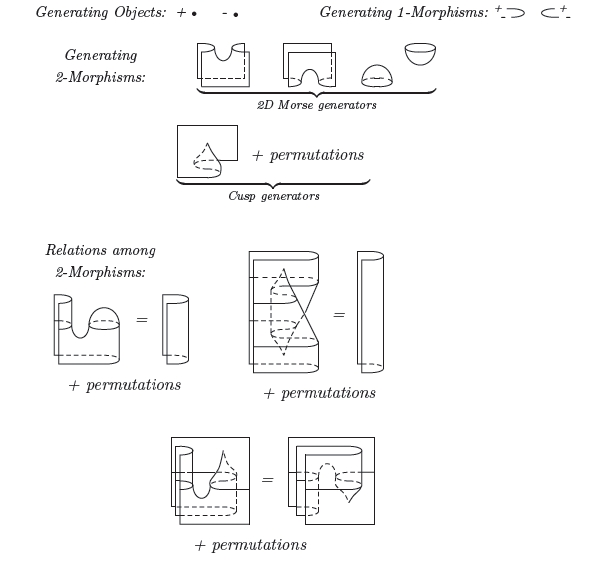I’ve written about this before - with some egg on my face, I might add, since I hadn’t read properly what Lurie had written, which is no doubt the case again - but darn it, I still feel that my only beef with Lurie’s brilliant paper is that he does not pay enough homage to the concept of “duals”.
Lurie’s paper argues that an extended TQFT is determined by a fully dualizable object in the target higher category — the gismo the TQFT assigns to the point.
My beef is with the phrase “fully dualizable object”. Essentially (see Definition 2.3.21) he defines a fully dualizable object to be one which can be equipped with a duality structure at all levels.
This doesn’t sound right to me… the duality should be an integral part of the structure of the object, and not a property.
Let’s look at extended 2d TQFT’s. The Baez-Dolan hypothesis says that a unitary 2d extended TQFT
(1)
should be determined by the 2-Hilbert space it assigns to the point. This means that there is supposed to be information in a 2-Hilbert space — enough information to have a 2d TQFT! And indeed, this was one of the things I tried to point out in my thesis: the information that a 2-Hilbert space carries are(is? help!) precisely the real scalar factors
(2)
the inner products of the identity morphisms on the simple objects with themselves. Different numbers? Then you’ve got a different 2-Hilbert space.
Why is this important? Because those numbers are precisely the numbers we need to define an ordinary (i.e. not extended) unitary 2d TQFT
(3)
This goes back to the early TQFT days of 1993 from a paper by Durhuus and Jonsson: a unitary 2d TQFT corresponds to a “unitary Frobenius algebra”. Since it’s unitary, it must be semisimple, and so the only information is the “eigenvalues of the handle operator”, which must be real numbers since the theory is unitary.
So it really works! A 2-Hilbert space (the gismo the extended TQFT assigns to a point) gives us precisely the right information to construct the rest of the TQFT, such as the numbers it will assign to closed 2-manifolds.
So the point I’m trying to make is: the information we need to determine a unitary extended 2d TQFT is not a “dualizable object” — which would be just a “2-vector space”, i.e. something of the form , but rather “an object equipped with a duality structure” — a 2-Hilbert space.
In the derived setting, the replacement for “2-Hilbert space” in the sense of the linear category assigned to the point in an extended 2d TQFT should probably be a “Calabi-Yau category” as in the work of Costello. And a Calabi-Yau category isn’t just a category which “is dualizable” — rather, the data of the Serre traces is an integral part of the structure of the category. A 2-Hilbert space is roughly the same thing as a linear category equipped with a trivial Serre functor. A Calabi-Yau category is basically a -category equipped with a trivial Serre functor. (Unfortunately this terminology is bad: a trivial Serre functor is nontrivial in general :-) The real information lies not in the Serre functor itself but in the Serre trace! Heh, lol. In a 2-Hilbert space, the Serre trace is given by taking the inner product with the identity morphism).
I have other issues along the same lines, for instance Definition 2.3.11 about a 2-category having “adjoints for 1-morphisms”. I agree that this definition is along the right lines, but it doesn’t go far enough… there is structure in the duality for 1-morphisms: the right adjoints need to be related to the left adjoints. For instance, in the 2-category Var, whose objects are derived categories of coherent sheaves, whose morphisms are integral kernels, and whose 2-morphisms are natural transformations, this relationship between right adjoints and left adjoints is given by the Serre functor. The same thing holds for duality for 1-morphisms in the 2-category of 2-Hilbert spaces.
Lurie does give a very interesting explanation of Serre functors in Remark 4.2.4. Maybe I am wrong on this… but his treatment makes it seem as if the Serre functor is canonical, whereas I am trying to say it is additional structure. Could someone kindly help me out on this? I might be misguided. It is certainly additional structure in the context of a semisimple linear category. Maybe not in the context of derived categories of coherent sheaves?
The same thing can be seen when you think of a moniodal category as a 2-category with one object. Then having duals for 1-morphisms in a 2-category corresponds to having duals for objects in the monoidal category. And the structure of relating “right duals” to “left duals” is nontrivial and interesting: it’s called a “pivotal structure” and there is still an outstanding conjecture by Etingof, Nikshych and Ostrik that such a structure exists! I’ve written about this before (I, II), so I apologize to regular denizens of the n-category cafe who are surely rolling their eyes at this stage if they bothered to read this far.
Of course Lurie’s paper is amazing. I’m just registering a little stumbling block I have about this issue of duals. I believe his paper already has the appropriate technology to talk about “object with fully dualizable structure” instead of “fully dualizable object”, and perhaps that is morally the way he treats it anyway! So maybe I’m just having a pedantic argument about terminology.


Re: This Week’s Finds in Mathematical Physics (Week 275)
Hi John,
Just a small typo. My name is “Chris” or “Christopher”. Not “Christian”.
I just wanted to set the record straight.